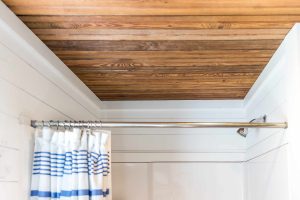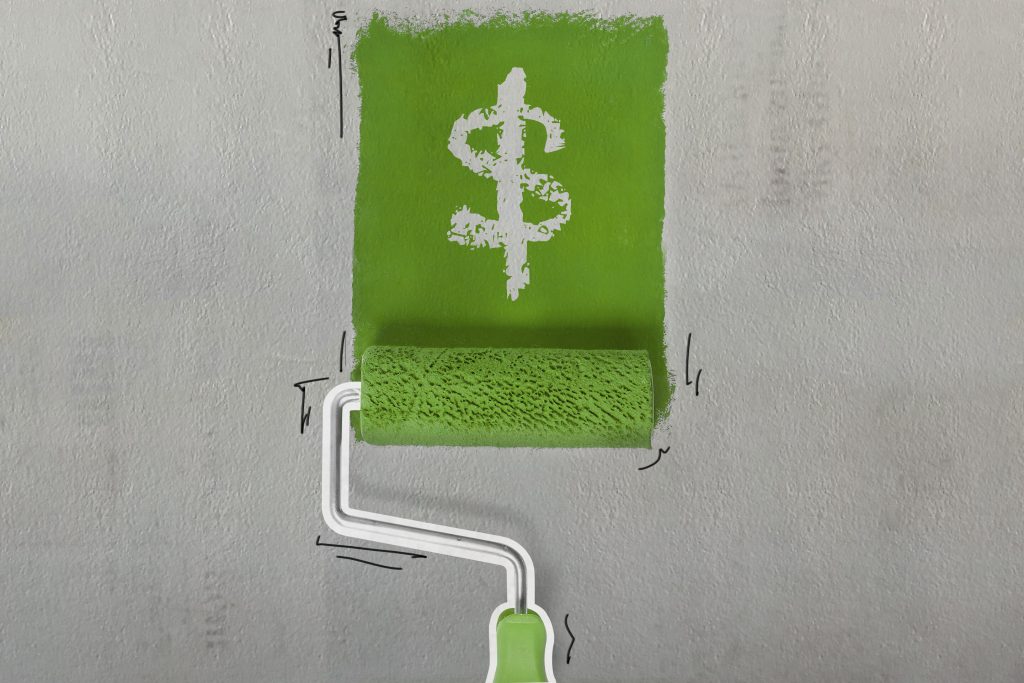- For older, damaged properties
- Low 3.5% down payment
- Fixed or adjustable rates
- Variable or adjustable low interest rates
- Federally insured
- No income limit
- Renovations will increase the home’s value quickly
- Can be combined with an FHA Title 1 loan
- Allows eligible cosigner
- Requires collateral
- 3.5% down payment is not available for credit scores lower than 500
- FHA approval needed for the entire process
- Has origination & closing fees
- Repairs must be for your primary residence
- There are maximum loan limits that vary by state
- Investment and commercial properties are not eligible
- Luxury upgrades like swimming pools are not eligible
- No DIY allowed
FHA Title 1 Property Improvement Loan – Best for homeowners with poor credit and low equity
An FHA Title 1 Property Improvement Loan helps homeowners finance renovations even if they don’t meet the credit and equity requirements of private lenders. The FHA insures the mortgage, which means that the government pays up to 90% of the loan if the borrower can’t repay it.
Loans with an FHA guarantee protect lenders against potential loss and ease qualification requirements for the borrower. Instead of looking solely at traditional metrics, lenders also evaluate your income and verify your employment. The maximum loan amount is $60,000, and loan terms are capped at 20 years.
While you must use a Title 1 loan for home upgrades, FHA restrictions allow for a bit more flexibility. As long as you use the funds for permanent repairs that improve the use and livability of the property, you won’t break the FHA’s rules.
You can even use the money to purchase certain appliances or renovate non-residential structures, mobile and manufactured homes. Unlike a 203(k) Rehab Loan, you may DIY or hire contractors at your discretion.
To qualify:
- You must own the property title or have a long-term lease
- You must be able to make monthly payments
- Your debt-to-income ratio must not exceed 43%
- You need to have occupied the house for a minimum of 90 days
Minimum credit score required: none set by the HUD, but this may vary by lenders
Average rates: Rates vary, but average rates range from 2.6% to 3.5%.
- Government-backed
- No home equity required
- Low, fixed interest rates
- Fixed monthly payments
- No prepayment penalties
- No collateral for loans under $7,500
- Can be combined with 203(k) loan
- Allows eligible cosigner
- Requires FHA-approved lender
- Requires FHA-approved appraisal
- Loan amounts over $7,500 require collateral
- Maximum loan limits
- Origination and closing fees
- Repairs must be pre-approved
- Excludes temporary repairs or luxury upgrades, like swimming pools
Cash-out refinance – Best for when mortgage rates are low
A cash-out refinance pays off your first mortgage and replaces it with a new, larger loan that results in a lump-sum cash amount for discretionary use. The new loan may have different terms, such as a different interest rate or length. Cash-out refinances can have fixed or adjustable rates.
Lenders generally allow borrowers to access around 80% of the home’s value, meaning they must leave about 20% equity in the home. For example, say your home is worth $300,000, and you still owe $200,000 on your current mortgage. You have $100,000 in equity, but most lenders won’t let you pocket that full $100,000 in your cash-out refinance.
Eighty percent of your home’s value, in this case, is $240,000. That’s the maximum loan-to-value ratio (LTV) for your new loan. When you refinance for that $240,000, you’ll get to keep the $40,000 as cash.
Since cash-out refinancing involves taking out a new mortgage, this option makes the most sense if the new loan offers better interest rates and terms and if you’re financing improvements that increase your home’s value and equity.
A mortgage refinance calculator can help crunch the numbers for you. If a cash-out refinance is a net positive, start researching and comparing loan rates from our best mortgage refinance companies of 2023.
Minimum credit score required: 620 or higher
Average rates: Rates vary, but average rates range from 6.0% to 8.0%
- Fixed-interest rates and monthly payments
- Lump-sum cash amount
- Unrestricted use
- Can finance the renovation of a rental property
- Increases total amount of debt
- Requires underwriting and appraisal
- Has originating and closing costs
- Requires a healthy DTI ratio
- Requires a good credit score
- Requires enough equity
Home equity loans (HEL) – Best for homeowners with stable income and high equity
Home equity loans are installment loans repaid over 5-30 year terms via fixed monthly payments. You’re essentially taking out a second mortgage, borrowing against your home equity to secure funding. This money may be spent on costly expenses like home improvements, college, debt consolidation, or long-term medical care.
A home equity loan amount cannot exceed 85% of your home equity, so it’s a good idea to have a budget in place for your renovation before considering this option. Also, consider how much you’ll pay in closing costs, origination and appraisal fees.
Home equity loans are risky. While they can fund important life expenses, they have high interest compared to first mortgages. The best home equity loans favor homeowners who can comfortably afford long-term debt and have built enough equity. Using them to get out of economic hardship is generally not advisable, as failure to repay puts your home at risk.
Minimum credit score required: 660 or higher
Average rates: Rates vary, but average rates range from 5.75% to 10.7%
- Fixed rates and monthly payments
- Lower rates than personal loans and credit cards
- Lump-sum cash amount
- Unrestricted use
- Interest may be tax-deductible
- Foreclosure risk
- Requires enough equity
- Requires a stable, reliable income
- Upfront application and appraisal costs
- Origination fees
- Requires strong credit score
Home equity line of credit (HELOC) – Best for homeowners with high equity who need flexibility
A home equity line of credit, commonly called a HELOC, borrows against home equity, just like a home equity loan. The difference is that a HELOC awards a revolving credit line backed by your home equity instead of a lump sum payment.
A revolving credit line awards you more flexibility than a lump sum, especially if the renovations don’t have a set price tag. You can withdraw money as needed up to a certain amount, but it’s common for lenders to set minimums and charge withdrawal fees.
HELOC interest rates will depend on your credit history, loan-to-value ratio and loan amount. Cosigners are one way to get a better rate but won’t have any ownership rights to the property.
Home equity lines of credit have an initial “draw period” (10 years in most cases), during which you can withdraw money. Repayment plans within this period vary. Some lenders allow you to start paying the principal plus interest in monthly installments, or interest first and principal at the end.
What matters most is that you must be ready to repay any outstanding debt in full after the draw period expires, whether by refinancing or some other means. Failure to do so risks foreclosure.
A HELOC’s flexibility can work against you if you use it irresponsibly and borrow beyond your means. Before settling on a HELOC, explore and compare every loan option and gather information from trustworthy sources. The Federal Reserve Board’s guide to HELOCs provides a great starting point.
Minimum credit score required: 660 or higher
Average rates: Rates vary, but average rates range from 3.75% to 6.8%
- APR rates are lower than most credit cards
- Revolving line of credit to be used at your discretion
- Offers flexibility on a renovation budget
- Lenders may waive closing costs
- Interest may be tax-deductible
- Foreclosure risk
- Requires enough equity
- Requires strong credit
- Higher rates than first mortgages
- Variable interest rates
- Added appraisal and closing costs
- Lenders may freeze or reduce credit line
- Rental properties do not qualify
Personal loan – Best unsecured option for good to excellent credit scores
Personal loans can be convenient for homeowners with good to excellent credit scores who need fast financing and don’t want to put their homes up as collateral.
The best personal loans are available from several private lenders and credit unions. The application process can be much faster than for the other financial instruments on this list, especially if you work with an online lender like Lightstream.
Many personal loan servicers also guarantee no prepayment penalties and direct funding to your bank account by the next business day. Monthly repayment plans tend to be significantly shorter than other financing options, with most options ranging between one to five years.
Lenders heavily weigh your creditworthiness during the application process and offer the best rates if you have excellent credit. To determine their risk, loan providers look at your credit history and use your FICO or VantageScore.
If your credit score needs work, you can find out how to repair your credit or look into our list of the best credit repair companies. Keep in mind that even the best personal loan interest rates may still be higher than for secured loan options since the lack of collateral or government insurance poses a higher risk for the lender.
Minimum credit score required: 620 or higher
Average interest rates: Rates vary, but average rates range from 6% to 36%
- No foreclosure risk
- No home equity requirements
- Lump-sum cash amount for discretionary use
- Fast funding
- Fixed or variable interest rates
- Lenders may waive origination fees
- Higher loan rates
- Requires good to excellent credit
- Short repayment term
- No federal loan benefits or protections
- Interests are not tax-deductible
Credit cards – Best for affordable, small-scale projects
Consider a credit card for minimal upgrades you can afford to pay in full but would prefer to finance over a few months, such as a paint job or a new appliance.
Many credit cards offer an introductory 0% APR period of 12 months, meaning you won’t pay any interest on the outstanding balance for a full year. You can also take advantage of any cashback rewards for home improvement-related purchases.
Best practices include never charging more than you can afford and keeping your credit utilization ratio below 30%. Credit card APR rates are some of the highest (around 16% to 24%), and outstanding debt can quickly snowball and plummet your creditworthiness. For large-scale home renovations or long-term projects, it’s best to consider other loan options.
Minimum credit score: varies per credit card type and company
Average interest rate: Rates vary, but average rates range from 16% to 24%
- No collateral needed
- 0% APR introductory period
- Unrestricted use
- You can use the credit line as needed
- Possible cashback rewards
- Very high APR rates
- High debt can become unmanageable
- Raises credit utilization ratio
- Best for simple, affordable repairs
- Interests are not tax-deductible
How do you choose the right home improvement loan?
To choose the best home improvement loan, examine your financial situation – your credit report, credit score, credit history, debt-to-income ratio, mortgage equity, and income. Determine the cost of your home improvement project, research your funding options and compare lenders to find the lowest rate.
Are you willing to put your home as collateral, or do you prefer an unsecured personal loan? Do you qualify for any federal loan programs? Our guide on how to get a home improvement loan can help you get started on your loan application.
Home Improvement Loans FAQ
How long are home improvement loans?
The term length of your home improvement loan depends on the type of loan you choose. Personal loan terms range from 12 to 60 months. Loans backed by your mortgage tend to have longer repayment periods. A home equity loan or home equity line of credit may last up to 20 years, and FHA caps its property improvement options at 20 years.
Where to get a home improvement loan?
You can get home improvement loans from your mortgage servicer, personal loan providers, or FHA-approved lenders. If you already own a home, consult with your bank and compare their offers with types of loans to get the best terms and lowest rates.
Can you use a home improvement loan for anything?
Personal loans meant for home improvement can still be used for other expenses, should the need arise. The same applies to funds acquired through a cash-out refinance, home equity line of credit, or home equity loan. Home improvement loans acquired through federal loan programs are stricter. After meeting eligibility requirements, pre-qualified contractors must make all repairs, and funds must be used for home improvements, as defined and approved by the lender and FHA.
Should I take out a loan for home improvement?
Everyone could pay for home improvements in cash in an ideal world, but repairs are often so expensive that a loan is the only option. If repairs are necessary and you plan on living there for many years, then yes, consider taking out a home improvement loan.
Summary of Money’s Guide to Home Improvement Loans
Home improvement loans are financing options for homeowners who want to upgrade their homes and can afford long term debt. Homeowners with enough equity may be able to fund expensive repairs with a cash-out refinance, home equity loan or home equity line of credit.
Qualifying borrowers who do not meet the credit or equity requirements should consider more affordable FHA loans tailored for home renovations, like a 203(k) Rehab Loan or Title I Property Improvement loan.
Personal loans charge higher interest rates but may offer a more flexible alternative if you have good to excellent credit. An advantage is that there are no collateral requirements and no use restrictions.
Make sure that the home improvement loan and renovation will pay for itself in the long run, increasing the value of your home and contributing to your overall quality of life.
Read the full article here














